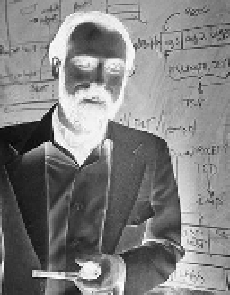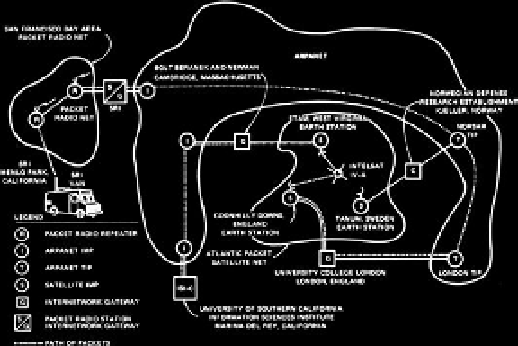Information Technology Reference
In-Depth Information
Fig. 10.16. The original conceptual
plan suggested by Cerf and Kahn for a
multinetwork system. This idea led to
the birth of the “network of networks,”
better known as the Internet.
traffic at a rate of ten megabits per second. Adoption of Ethernet technology
rapidly outpaced several competing technologies, and Ethernet became the
dominant technology for building LANs.
The TCP/IP protocol and the Internet
Kahn and Cerf had first worked together in 1970 when Kahn was perform-
ing his network congestion experiments (
B.10.16
). By 1973, there were a num-
ber of different international packet-switching networks, and members of the
network community had discussed what was needed to link them together.
Typically the networks would have different interfaces, packet sizes, and trans-
mission rates. Kahn and Cerf came up with the idea of a “gateway” computer.
To connect the ARPANET to the gateway machine, the machine must just look
like a host to the ARPANET IMPs. But to connect to another network, such as the
ALOHAnet radio network, the gateway software must also allow the machine
to look like a host on that network. Each network could still send messages to
its own machines using its own protocols, but when data needed to be sent to
another network, a new and universal networking protocol was needed - a set
of rules that any computer connected to the network could follow to send or
receive data.
In May 1974, Cerf and Kahn wrote a paper describing such a proto-
col (
Fig. 10.16
). They proposed that messages should be encapsulated in
self-contained packets of information with the source and destination
addresses written into the header, in much the same way that letters are put
into envelopes and sent to their destination. The gateways would read the
addresses on the “envelopes,” but only the receiving host would read the con-
tents. This set of rules, called the Transmission Control Protocol (TCP), also
made the assumption that the packet-switching network was intrinsically
unreliable. In the construction of the ARPANET, it had been the IMPs that
provided the reliability: now the focus of reliability shifted from the network
to the communicating host computers. Cerf and Kahn led the discussion with
the ARPANET participants and with the growing international networking
community. This community included Donald Davies in the United Kingdom
and Louis Pouzin in France, who was building a packet-switching network
B.10.16. Vint Cerf studied mathe-
matics at Stanford and earned his
PhD in computer science from UCLA
in 1972. After receiving his doctor-
ate, he became an assistant professor
at Stanford and worked with Bob
Kahn on the TCP/IP protocol for net-
work interoperability, the basis for
the modern Internet.


Search WWH ::

Custom Search